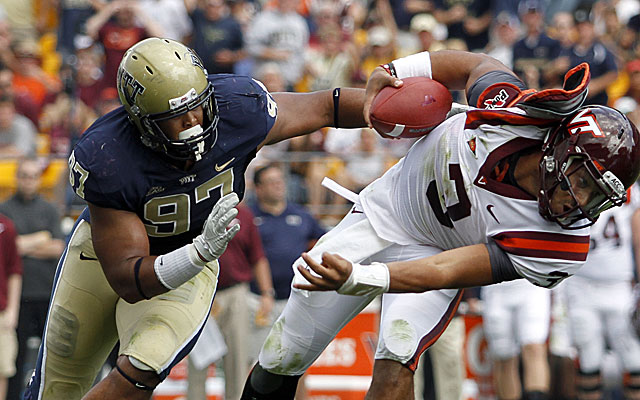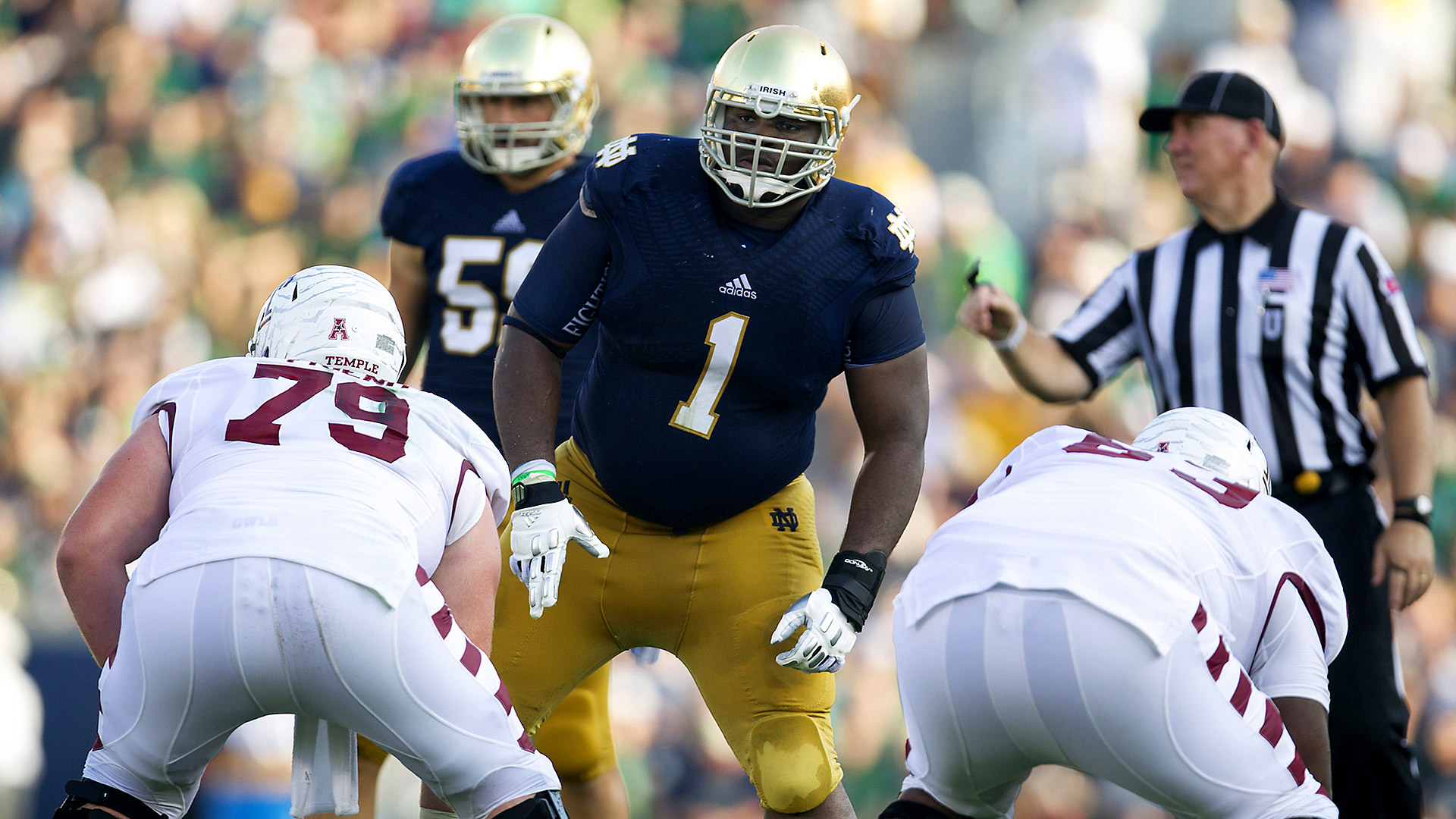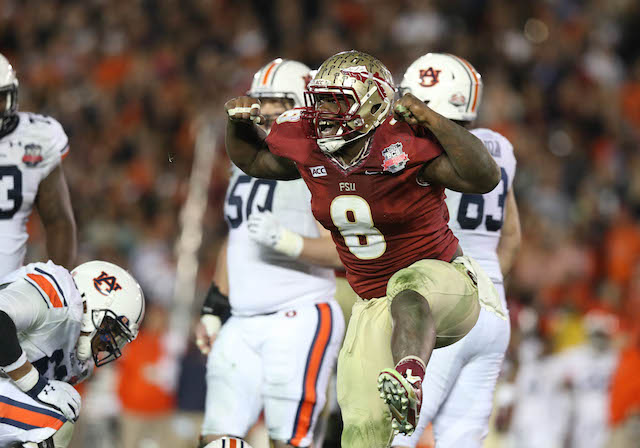Last
week I went through the best offensive players available in the draft, and this
week I've moved on to the defensive side of the ball. I've broken the available
players into four categories based not on explicit positions but on how they
will be used in the NFL: Defensive Backs, Interior Linemen, Linebackers, and
Pass Rushers.
In each
position group it seems the common theme is the choice between present skill
and athletic potential. More often than not I found myself siding with those
who have already shown the technique to play in the NFL, but this isn't a
condemnation of players whose value is based on their athleticism. It is highly
likely that some of my lesser ranked prospects will turn out to be the best,
but because of the risk involved I couldn't justify putting them above their
more proven peers.
Again, all the film I watched came from the wonderful website Draft Breakdown. You should really check it out sometime if you have interest in the draft.
Again, all the film I watched came from the wonderful website Draft Breakdown. You should really check it out sometime if you have interest in the draft.
Defensive Backs
Darqueze Dennard, CB, Michigan State

Dennard has been steadily falling
as the pre-draft process has gone along, as one would expect from a player who
can’t match up athletically with his peers. After being a top ten pick in some
early projections, a 4.51 time in the 40 yard dash has knocked him potentially
out of the top twenty. Of course, this isn’t new information. Dennard has
always been slow for a top cornerback, and it shows on the field. He doesn’t
have the ability to chase down receivers when he is beaten, so he takes care
not to let himself be beaten. His technique is excellent, and he is quick to
turn his hips when he sees a receiver running deep. The downside is that he
plays without aggression, and he can be beaten underneath by well run out
patterns and curls.
What puts Dennard above the other
cornerbacks is his physicality. He enjoys throwing himself into the backfield
as a run defender, and he is an excellent tackler in the open field. He doesn't bring this physical presence to his coverage, though he will occasionally use
his hands to prevent a receiver from crossing his face. In college he preferred
to turn and run with a receiver rather than trying to stonewall him at the
line, but I think he has that capability if properly coached in the NFL. These
tools together give him the ability to bump inside and play in the slot,
versatility the other cornerbacks in the draft lack.
Ha Ha
Clinton-Dix, S, Alabama

Clinton-Dix may be the most
fundamentally sound player available in this draft. Surrounded by talent at Alabama, he was never
required to make flashy, game altering plays. His job was usually to sit back
in a deep zone and to protect over the top while his teammates controlled the
game up front. He never allows receivers to get behind him, and he is a sure
tackler in the open field, whether it is against receivers after the catch or
moving up in run support. He always breaks down before making a tackle, and he
never attempts to just knock a player out instead of wrapping him up.
The concern I have with
Clinton-Dix is how he will transition to the NFL, where he won’t be constantly
surrounded by top notch defensive talent. If a team looks to him to make big
plays, they will wind up disappointed. He doesn’t cover ground particularly
well, leaving him a couple steps behind where he would need to be to intercept
deep throws. Though his balanced approach against the run prevents broken
tackles, it slows him down and allows ball carriers to pick up an extra couple
yards on each run. These concerns are worth addressing, but they aren’t worth
too much thought. There is nothing wrong with having a solid, reliable safety
in the NFL, and that is what Clinton-Dix will be.
Bradley Roby, CB, Ohio State

Roby may be the most difficult
player to figure out in the draft. In 2012 he looked like a future superstar, a
cornerback who would fly around the field making plays for years to come. He
made incredible breaks on the ball, had the speed to make up for any errors he
committed, and had wide receiver instincts for playing the ball when it was in
the air. He was every bit as committed to stopping the run as Dennard, even if
he occasionally struggled to get off blockers. Everything we saw from Roby
during his sophomore season suggested that he would be a top ten pick when he
was finally eligible to come out.
And then 2013 happened. Ohio State’s
defense was up and down throughout the season, and Roby’s inconsistency had a
great deal to do with their struggles. He still flashed the brilliance that
made him one of the nation’s best players in 2012, but teams became smarter at
exploiting his aggression with double moves. He was asked to play more zone
coverage, and he frequently became lost drifting in space while receivers ran
past him. But he showed enough to suggest he can return to the dominant
player he was two years ago, and a strong performance at the combine has pushed
him back into the first round. He is the best in the draft at pressing
receivers and breaking on the football, and if properly coached he has the
highest upside of any of the top cornerbacks.
Calvin Pryor, S, Louisville

Clinton-Dix may lack flashiness
at the safety position, but Pryor more than makes up for it. Though both
players ran identical times of 4.58 in the 40 at the combine, Pryor plays
significantly faster. He flies all over the field in both the run
and the pass, operating on an instinctive level that often takes him outside
the defensive scheme. This leads to big plays, but it also causes problems. He
will sometimes jump a route, leaving his zone to run at an already covered
receiver. For this reason he didn’t spend a great deal of time playing in a
deep zone at Louisville,
instead covering the flats or matched up man to man on a slot receiver. This
versatility is a bonus in the NFL, but it means little unless he can learn to
be more disciplined in deep coverage.
His frantic aggression is even
more noticeable in the running game. He flies towards the line the moment he
reads run, hitting blockers and ball carriers at a dead sprint. This allows him
to make plays nearer to the line of scrimmage than Clinton-Dix does, but it
also leads to him playing out of control at times. He will sometimes run to a
gap only for the running back to cut the opposite way, taking himself out of
the play. He also has a habit of throwing himself full speed into a ball
carrier’s legs rather than breaking down and wrapping up, leading to missed
tackles. Like Roby, Pryor is a bit of a project. But he has plenty of ability to
bring excitement and game changing plays to a defense.
Justin Gilbert, CB, Oklahoma State
In terms of raw size and
athleticism, Gilbert stands above the rest of the cornerbacks in the draft. His
height is only slightly above average, but his long arms can close down a lot
of throwing windows. Toss in a 4.37 time in the 40 and the agility of a punt
returner, and you have an athletic package that leaves most coaches and fans
drooling. If his coverage skills were anything above average, we would be looking
at one of the best players in the draft.
The problem is that Gilbert
doesn’t come close to matching either Roby or Dennard in coverage ability. The
speed to catch up to a receiver on a blown coverage is a plus, but a cornerback
who is forced to rely on it multiple times each game likely suffers from poor
technique. A fast receiver can run past Gilbert before he gets his hips turned
around, and despite his size he rarely uses his hands to impede a receiver’s
progress. He brings no physical presence to the pass defense, and he is
nonexistent against the run. He lacks Roby’s ability to make sharp breaks on
the ball, and he doesn’t come close to matching Dennard’s technique. This means
that he can be beaten both underneath and over the top. His length and athleticism
allow him to shrink these windows more than most cornerbacks, but the windows
still exist for well placed and well timed throws to exploit. For these
reasons, I would not even consider selecting Gilbert until late in the first
round.
Interior Linemen
Aaron Donald, DT, Pittsburgh

The best defensive player in
college football last season had one of the best performances of any player at the combine, and yet he still may not be
selected in the top ten. Donald is undersized at only six feet tall and 285
pounds, and he has a bit of an unfair reputation as a player who only succeeds
through pure effort. The word most often used to describe his play is
‘relentless’, and somehow this has become a negative for him. People become so
engrossed in how hard he tries on each play that they overlook how talented and
skilled he is as a football player.
Donald dominated college football
last year due to a rare combination of athleticism and technique. He gets off
the ball quickly, and once engaged with a blocker he has a number of tools he
can use to beat him. He has shown a swim move, a bull rush, and a spin move,
but his most common tactic is to simply swat the blocker’s hands away before
using his speed to run past. Though he is smaller than desirable, he has long
arms that help him when hand fighting with linemen. He doesn’t have the length to play
defensive end in the 4-3 or the 3-4, and he doesn’t have the size to play nose
tackle in either front. This isn’t the problem it was a couple years ago, as
teams have gotten smarter at playing varied fronts that work to their players’
strengths. Donald should go in the top ten, and if he falls past that he will
be one of the steals of the draft.
Ra’Shede Hageman, DE/DT, Minnesota

Relentless effort is the most
commonly praised part of Donald’s game, and it is the most commonly criticized
part of Hageman’s. An athletic marvel, Hageman shows flashes of dominance
interspersed with long periods of apparent indifference. He rarely bothers with
backside pursuit, and he is content to hold his ground against a double team
rather than trying to fight through it. He wasn’t an every down player at Minnesota (though this
was likely because the coaches liked to rotate all their defensive linemen) and
he rarely took over games as one would expect of a player of his abilities.
All that said, the flashes of
excellence he showed were staggering, more than enough to push him up into the
first round. He always comes off the ball hard, knocking offensive linemen a
yard backwards with his initial contact. He possesses no moves to disengage
from blockers, but every now and then he can break free by pure strength alone
and swallow a ball carrier in the backfield. As a pass rusher he only ever
tries a bull rush, and once past the initial surge the only thing he can do is
bat down passes. Coaches look at a player like Hageman who can dominate on pure
talent alone and wonder what he could do if taught how to play with technique.
Whether he is capable of being coached remains the crucial question, and it is
something teams will have to figure out during their pre-draft meetings with
him.
Louis Nix, DT, Notre Dame

Nix has a reputation as the
premier run-stuffer in the draft, so I was surprised to see the value he brings
as a pass rusher. He isn’t particularly quick off the ball or the through the
gaps, but he plays well with leverage, getting beneath offensive linemen and
using his strength to twist their shoulders so he can get past them. If single
blocked, he can turn a lineman around and create pressure in a passer’s face.
Unfortunately, he doesn’t actually disengage from the blocker, and good
quarterbacks will be able to recognize this and step to the side the offensive
lineman has sealed off. Nix can disrupt a passing play, but he isn’t going to
collect a lot of sacks.
In a lot of ways, Nix is a
similar player to Hageman. He isn’t nearly as quick or as strong, but he has a
similar style of flashing dominance just often enough to be intriguing. He
draws a lot of double teams but rarely fights past them, and his game relies
almost solely on his ability to bull rush a lineman. He uses his hands to
disengage more often than Hageman, but this is still a weakness in his game. Right
now I would say that he is the superior player, but I have him ranked lower
because of a lack of positional versatility. Both players can play nose tackle
in either a 4-3 or a 3-4, but Hageman has the ability to slide outside and
contribute as an under tackle or a 3-4 defensive end. Nix is only capable of
playing in the heart of the defensive line, a position whose value has
diminished over the past few years.
Timmy Jernigan, DT, Florida State

This seems strange to say about a
defensive tackle, but Jernigan shows very little interest in playing against
the run. He comes off the ball almost straight up, engaging the blocker at the
line of scrimmage and not bothering to disengage unless he reads pass. He is
frequently driven a couple yards backwards by the initial surge, and even if he
does get off his blocker he rarely bothers pursuing a play going away from him.
Altogether, Jernigan is one of the worst defensive tackles I have ever seen
against the run.
It is fortunate then that he has
so much talent as a pass rusher. Though he can’t match the athleticism or
strength of Hageman and Nix, he has a number of moves he can use to break free
from blockers. He swats their hands away to free himself from the initial
contact, and he possesses a devastating swim move that gets him unchecked into
the backfield. He would be even more dangerous if he came off the ball quicker
and stayed low as he tried to shoot through the gaps, but his current skills
will catch the eyes of the teams that scout him. Jernigan is likely a second round
prospect, but he has the potential to slip up into the first round if a team
falls in love with his pass rushing abilities.
Linebackers
CJ Mosley, LB, Alabama

Mosley is the prototypical run
stuffing middle linebacker. He plays physical, downhill style, and he is at his
best between the tackles. From the moment he recognizes a running play, he attacks
towards the line of scrimmage and into the backfield. He has the strength to
plug up blockers in the hole, and he excels at
fighting past linemen trying to reach him on the second level. Ten or twenty
years ago he would have been a top ten pick in the draft, but in the modern NFL
a linebacker needs to be able to do more than stuff up the interior running
game.
Mosley is a solid player against
the pass, and it shouldn’t be necessary to take him off the field in passing
situations. He has a good sense of how to drop underneath the seam and slant
routes, and he does a good job playing the ball in the air (even if he
struggles to catch it.) He will be useful in the passing game, and no team
should avoid taking him because of this. The biggest concern with Mosley is his
lack of speed. While he excels within the tackle box, he rarely makes plays
outside of it. Once a runner gets outside he needs to take a wide angle just to
catch him, and he usually cannot become involved on a play at the sidelines
until the runner is already ten yards downfield. If I’m looking to invest a top
twenty pick in a linebacker, I want someone who will play from sideline
to sideline. As talented as Mosley is, he will never be that player.
Ryan Shazier, LB, Ohio State

Like most projections, I have
Shazier ranked below Mosley among inside linebackers. He is a less polished
overall player, and his upside is only slightly higher than Mosley’s. But I
don’t think it would necessarily be a mistake if he was the first linebacker to
go off the board. He and Mosley are very different players—everything I
criticized about Mosley is something Shazier excels at—and it is undeniable that Shazier is better suited for the modern NFL. He is significantly
more athletic, running an absurd 4.38 in the 40 yard dash. He regularly chases
runners down from behind, and he covers ground from sideline to sideline as
well as any linebacker I’ve seen.
I have Shazier ranked lower
because, even though he is more suited to playing linebacker in the modern NFL,
he falls short in more areas than Mosley. Inside the tackle box he can be
overwhelmed by blockers and caught up in the wash. He isn’t as sure a tackler
as Mosley, and he can be knocked backwards by a powerful runner. He has bulked
up some since leaving college, but it remains to be seen whether he can adjust
to the physicality of playing inside linebacker in the NFL. These shortcomings
are enough to drop him to the end of the first round, where some team will fall
in love with his instincts and athleticism.
Pass Rusher
Jadeveon Clowney, DE, South
Carolina

The 2012 version of Clowney would
be the undisputed top player available in this draft. The lesser 2013 version
would still go in the top ten. The narrative of his decline has been greatly
exaggerated over the past year, and you only need to look at the tape to
realize what Clowney is capable of offering. Even with minimal effort he was
always the best player on the field, and he still flashed enough moments of
dominance to let everyone know what he is capable of. If I was just evaluating
his 2013 season and his combine results I would see an athletic monster with
great potential as a pass rusher, provided he can develop an array of secondary
pass rush moves.
But we have already seen that he
has these moves. We saw them for a full season, and even though he spent most
of last year surrendering once his initial rush was handled, I have complete
faith that he is capable of returning to the player he was. He has always had
an explosive first step that allows him to beat a tackle around the edge, but
what truly sets him apart is his underrated ability to win against a blocker
after the initial surge is handled. He strikes with his hands first to create
separation then uses his strength to control the man in front of him. As
explosive as he is, he needs only a moment of leverage to swipe away a
blocker’s arms and race past him. Clowney is a complete football player, both
as a pass rusher and a run defender. He plays with aggression and discipline,
pursuing plays from behind while still doing his job to keep contain. I have no
complaints about his game, only about his attitude, which I am in no position
to evaluate. If he can commit to playing football professionally, he will be the best player to come out of this draft.
Khalil Mack, OLB, Buffalo

Mack did just about everything
for Buffalo on
defense last year, but he was at his best as a pass rusher. He only rushed on
about half the defensive plays, but when he did he was a nightmare in the
backfield. His lateral quickness allows him to sidestep blockers, and he does a
fantastic job keeping himself low to slide underneath the arms of a taller
tackle. His initial get-off was slowed occasionally by his stance, which was
more balanced as one would expect from a traditional linebacker. In the NFL he will spend most of his time set up as a pass rusher, and it will be even easier for him to rush around
the edge. When he did line up in a pass rushing stance in college, he was every
bit as quick up the field as you would like to see from an elite pass rusher.
Mack’s skill with his hands isn’t
quite on the same level as Clowney’s, but it is still well above average. It is
almost impossible to cut him, as he uses his hands to push aside anyone who
tries diving at his knees. It is rare to see a blocker truly control him, and
even if a lineman gets his hands into Mack’s chest his position is not secure.
Lateral quickness allows Mack to force the blocker’s arms outside his frame to
draw a lot of holding penalties, and strong hands give him the ability to
disengage at will. His best pass rush move is probably his bull rush. He keeps
his hips low as he drives the lineman deep into the backfield, and once he is
within reach of the quarterback he has no trouble casting the blocker aside.
Mack will need some time at the NFL level to adjust to his role as a full time
pass rusher, but once he does he will be one of the best in the league.
Anthony Barr, DE/OLB, UCLA

Nothing can be written about Barr
without mentioning that he was a running back just two years ago, before the
UCLA coaches decided to test his talents on the other side of the ball. Since
then, his draft stock has faced a similarly tumultuous path. He spent most of last
season as a projected top ten pick before falling in early projections, only to
rise back into the top ten over the past few weeks. This isn’t surprising from
a player who looks like an athletic freak on the field but struggled at the
combine, who still often looks like he doesn’t know how to play the position
yet can dominate on the edge.
Barr is more polished than you would expect from someone still
learning the position, but he still has lapses during which he clearly looks
like a running back playing linebacker. His jump off the ball is adequate, but
he doesn’t have the instant acceleration out of a two point stance to run
around the edge as a stand up linebacker. He is more effective when he can
start slow, get the tackle into a set position, then accelerate past him into
the backfield. He doesn’t possess many other moves, but when he gets his hands
up and extended he can control the blocker in front of him. This applies just
as much in the run game as it does in the pass game, and he shows the ability
to be a dominant two way player. He will need more development than either of
the two pass rushers above him, but it would not be ridiculous for a team to
snag him in the top ten.
Dee Ford, DE/OLB, Auburn

Ford is the best bet for a team
hoping to find an impact pass rusher late in the first round. Though he lacks
the athleticism and refinement of the higher ranked players, Ford has the
ability to be a dangerous pass rusher in the NFL. His game is predicated on
quickness, on his ability to beat a tackle around the edge with a traditional
speed rush. He will occasionally bow too far outwards on this rush, giving the
quarterback a lane to step up behind him. He will need to get stronger to
prevent this in the NFL, and he will need to learn to keep himself lower to
play with better leverage on a blocker.
Where Ford clearly falls short of
elite players like Clowney and Mack is in technique. He has a few moves he can
use that play off his speed rush—every so often he displays a nice jab step to
the inside or the outside in order to get a tackle off balance—but he lacks the
secondary moves of an elite pass rusher. He allows blockers to get into his body
too easily and rarely uses his hands to knock them away. The only technique
that can succeed without the hands is a spin move, and Ford’s attempts at this
were laughable failures. These techniques can certainly be taught at the next
level, but they knock him a notch below the more polished options at the top of
the draft.
Kony Ealy, DE, Missouri

As a prospect Ealy is on a
similar level to Ford, though they are very different players. Ealy isn’t
particularly quick, and he rarely beats pass protectors with a speed rush.
Instead he relies on his strength. He can sometimes get beneath a tackle and
get his outside shoulder turned to open a lane to the quarterback, but he is
much better as an interior rusher. For these reasons he may project better as a
3-4 defensive end, though he will have to add some weight to play that
position. He splits double teams well as a pass rusher, but he doesn’t hold his
ground well against two run blocking offensive linemen.
Ealy’s shortcomings are similar
to Ford’s. He doesn’t use his hands particularly well, and he has no counters
to using his strength to push past poorly positioned linemen. He doesn’t
possess a particularly dangerous bull rush, and if a blocker can get himself in
good position with a stable base, Ealy is essentially handled. He is better as
a run defender than most of the other pass rushers in the class, but he needs
to improve as a defender at the point of attack. When given the chance to chase
a play down from behind he is both relentless and disciplined, but when a team
runs straight at him he offers little resistance. Ealy has significantly less
upside than any of the four I’ve listed above him, but he is probably still
worthy of a late first round pick.
No comments:
Post a Comment